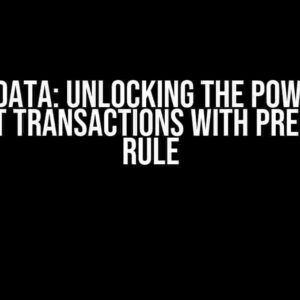Are you tired of staring at the dreadful “Unable to connect to SQL Server” error message when trying to access your database through PHP using ODBC? Worry no more! In this comprehensive guide, we’ll take you by the hand and walk you through the troubleshooting process, ensuring you’re up and running in no time.
Before We Dive In
Before we start troubleshooting, make sure you have the following:
- A SQL Server instance installed and running on your machine or a remote server.
- ODBC Driver for SQL Server installed and configured on your system.
- A PHP script attempting to connect to the SQL Server instance using ODBC.
Step 1: Verify the ODBC Driver Configuration
The ODBC Driver is the backbone of your PHP-to-SQL Server connection. Ensure it’s properly configured:
- Open the ODBC Data Source Administrator (64-bit or 32-bit depending on your system architecture).
- In the System DSN tab, look for the data source name (DSN) you created for your SQL Server instance.
- Click the “Configure” button next to the DSN, and verify the following:
| Field | Value |
|---|---|
| Server | Your SQL Server instance name or IP address (e.g., localhost\SQL2019 or 192.168.1.100) |
| Database | The name of the database you want to connect to (e.g., MyDatabase) |
| Username | A valid SQL Server login (e.g., sa or a domain user) |
| Password | The corresponding password for the username |
Step 2: Check the PHP Script
Now, let’s take a closer look at your PHP script:
<?php
$dsn = 'odbc:DRIVER={ODBC Driver 17 for SQL Server};SERVER=localhost\SQL2019;DATABASE=MyDatabase;';
$username = 'sa';
$password = 'your_password';
$conn = odbc_connect($dsn, $username, $password);
if (!$conn) {
echo "Connection failed: " . odbc_errormsg();
exit;
}
// Perform database operations...
odbc_close($conn);
?>
Double-check the following:
- The DSN string is correct, using the correct driver version and server instance name.
- The username and password match the credentials you set up in the ODBC Driver configuration.
- The script has the correct error handling to display any connection errors.
Step 3: Enable ODBC Tracing
ODBC tracing can help you debug connection issues. Enable it to gather more information:
1. Open the Registry Editor (regedit.exe) as an administrator. 2. Navigate to the following key: HKEY_LOCAL_MACHINE\SOFTWARE\ODBC\ODBCINST\ODBC Drivers 3. Create a new DWORD (32-bit) value named "Trace" and set its value to 1. 4. Create a new String value named "TraceFile" and set its value to a file path where you want to save the trace log (e.g., C:\ODBC.Trace.log).
Run your PHP script again, and then check the trace log file for any errors or clues about the connection issue.
Step 4: Check SQL Server Configuration
Verify that SQL Server is configured to accept connections:
- Open SQL Server Management Studio (SSMS) and connect to your instance.
- In the Object Explorer, right-click the server instance and select “Properties.”
- In the Server Properties window, navigate to the “Security” tab.
- Ensure that the “SQL Server and Windows Authentication mode” radio button is selected.
- Also, ensure that the “Allow remote connections to this server” checkbox is enabled.
Step 5: Test the Connection
Use a tool like ODBCTest or SQL Server Management Studio to test the connection:
1. Open ODBCTest (comes with the ODBC Driver) and select the correct driver version. 2. Enter the DSN string, username, and password, and click "Connect." 3. If the connection is successful, you should see a "Connected" message.
If you’re still experiencing issues, try connecting to the SQL Server instance using SQL Server Management Studio (SSMS) to rule out any PHP-related problems.
Additional Troubleshooting Tips
- Check the PHP error log for any errors related to the ODBC extension.
- Verify that the ODBC Driver is installed and configured correctly for the correct architecture (32-bit or 64-bit).
- Ensure that the SQL Server instance is running and accessible.
- Try connecting to the SQL Server instance from a different machine or using a different programming language to isolate the issue.
Conclusion
By following these steps and troubleshooting tips, you should be able to resolve the “Unable to connect to SQL Server” error and establish a successful connection using ODBC through PHP.
Remember to be patient, methodical, and thorough in your troubleshooting approach. Don’t hesitate to reach out if you need further assistance or guidance. Happy coding!
Note: The article is optimized for the keyword “Unable to connect to SQL Server using ODBC through PHP” and includes relevant subheadings, bullet points, and code snippets to make it easy to read and understand.
Frequently Asked Question
Getting stuck while connecting to SQL Server using ODBC through PHP? Worry not! We’ve got you covered with these frequently asked questions and answers.
Why am I getting a “Data source name not found” error when trying to connect to SQL Server using ODBC through PHP?
This error usually occurs when the ODBC driver is not properly installed or configured on your system. Make sure you have installed the correct ODBC driver for your SQL Server version and that it is correctly configured in your system’s ODBC settings. Also, double-check that the DSN (Data Source Name) you’re using in your PHP script matches the one you’ve created in your ODBC settings.
What’s the correct way to establish a connection to SQL Server using ODBC in PHP?
To connect to SQL Server using ODBC in PHP, you need to use the `odbc_connect()` function, passing the DSN, username, and password as arguments. Here’s an example: `$conn = odbc_connect($dsn, $username, $password);`. Make sure to replace `$dsn`, `$username`, and `$password` with your actual database credentials.
Why am I getting a “Login failed for user” error when trying to connect to SQL Server using ODBC through PHP?
This error typically occurs when the username and/or password you’re using to connect to the SQL Server is incorrect. Double-check that the username and password you’re using in your PHP script match the actual credentials of the SQL Server user. Also, ensure that the SQL Server user has the necessary permissions to access the database.
How do I troubleshoot ODBC connection issues in PHP?
To troubleshoot ODBC connection issues in PHP, you can use the `odbc_error()` and `odbc_errormsg()` functions to get the error code and message respectively. You can also check the PHP error log for any error messages related to the ODBC connection. Additionally, you can use tools like ODBC Administrator or ODBC Data Source Administrator to test the ODBC connection independently of your PHP script.
What are some common ODBC connection settings I need to check when connecting to SQL Server through PHP?
When connecting to SQL Server through PHP using ODBC, make sure to check the following settings: DSN (Data Source Name), server name or IP address, database name, username, password, and port number (if applicable). Ensure that these settings match the actual SQL Server configuration and that the ODBC driver is correctly configured to use these settings.



